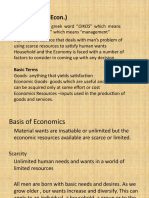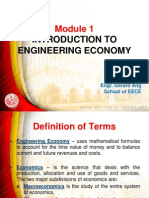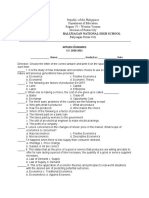BME Pre Finals Reviewer
BME Pre Finals Reviewer
Uploaded by
Nathaniel VillarCopyright:
Available Formats
BME Pre Finals Reviewer
BME Pre Finals Reviewer
Uploaded by
Nathaniel VillarOriginal Description:
Copyright
Available Formats
Share this document
Did you find this document useful?
Is this content inappropriate?
Copyright:
Available Formats
BME Pre Finals Reviewer
BME Pre Finals Reviewer
Uploaded by
Nathaniel VillarCopyright:
Available Formats
BME Pre Finals Reviewer
Consumer Behavior
Basic Principles of Consumer Preference
Limited income prompts consumer choice – A consumer considers his/her limited income in purchasing goods and
services.
Consumer choice is decided on purpose – A consumer often selects the product which gives the higher benefit if
he/she chooses between two (2) products of the same cost.
There are alternative products – A consumer buys goods to satisfy his/her want or need. There are many alternatives
to satisfy consumers’ wants and needs.
Consumers make choices based on past experiences and knowledge, not necessarily on complete information – A
consumer would exert his/ her effort and time on researching the information of the goods depending on how much
he/she values the goods
The law of diminishing marginal utility applies to consumer preferences – A consumers’ behavior in purchasing
goods and availing services applies to the law of diminishing marginal utility.
Utility – is defined as the subjective personal advantage or fulfillment from obtaining goods.
Marginal Utility – is derived from the consumption of an additional unit of a good.
Utility and Demand
Theory of Utility – it states that if all else is equal, a rational consumer will prefer the option that brings the highest utility. The
utility is measurable in utils.
The ways to measure utility are as follows:
o Ordinal Utility – ranks the order of satisfaction or benefits of the options available for the consumers
o Cardinal Utility (Measurable Utility) – this does not only rank the consumers’ options but also shows the differences
in the magnitude of consumer preference with one option over another.
Law of Diminishing Marginal Utility – The marginal utility (satisfaction) obtained from consuming a particular good decrease
as the number of consumption increases, which show an inverse relationship.
Law of Demand – Price also decreases as the consumptions (quantity demanded) increases.
Prices and Consumer Choices – Prices directly affect consumer choice.
Substitution Effect
- effect caused by a change in the price of a product leads the consumer to replace the product with alternative goods at lower
prices
- price-dependent
- if the price of a product increases, the consumers tend to find an alternative product, assuming that income is constant
Income Effect
- the effect on the demand for a product due to change in the real income of consumers caused by the price movement of the
product.
- income-dependent
- if the price of a product increases, it automatically decreases disposable income.
Price Elasticity
Concept of Price Elasticity
Elasticity – measures the responsiveness of one (1) variable when other variable changes
Price Elasticity – specifically measures the responsiveness of demand and supply to price changes.
Price Elasticity of Demand
- in general, when the price of a product increases, its demand decreases while the supply increases.
- responses can be quantitatively large or small depending on how valuable the product is to the buyers, how many options are
offered, and how much time is still available to adjust choices.
- important to determine the elasticity of demand as this is one of the tools the sellers use to strategize their product pricing.
Determinants of Price Elasticity of Demand
Availability of alternative goods or services – if there are many available options or alternatives, price elasticity tends
to be more elastic.
Share in the total income to be spent on the good or services – if a product or service would take up a large portion
of a consumer’s budget, s/he would most probably think twice about purchasing the said product or service in case its
price increases.
Time dimension to responsiveness – if a consumer given only a short time to decide on his/her options, the demand
will most likely be inelastic since s/he might just stick to the original product or service s/he is looking for despite the
price increase.
The necessity of products or services – the demand will be inelastic despite price changes if the product or service is
a basic necessity.
Price Elasticity of Supply
- the gauges of the responsiveness of producers to price changes
- is computed similarly to the demand
Determinants of Price Elasticity of Supply
Availability of resources – if the resources or alternatives needed to produce goods can be easily obtained, the supply
tens to be elastic.
Other uses of inputs – producers may have other options on what to manufacture using their resources.
Required time on producing additional units – the supply of seasonal crops is considered inelastic since producing
more of them would take time.
Income Elasticity of Demand – as discussed in the law of demand, products can be classified as normal and inferior goods.
Normal goods – are goods whose demand increases as consumers’ income increases.
Inferior goods – goods whose demand decreases when the income of consumers increases.
Macroeconomics – economies experience short-term performance ups and downs istead of steady growth rate.
Business cycle – referring to ups and downs
Aggregate output – the primary measure of economic performance
Expansion or a boom – the period from a trough(or bottom of the cycle)
Contraction, Recession, or Slump – the period from a peak to a trough when output and employment fall.
Depression – a prolonged and deep recession.
Inflation and Deflation
Inflation – is an increase in the overall price level
Hyperinflations – a periods of rapid increases in the overall price level
Deflation – a decrease in the overall price level
The Circular Flow Diagram – a useful way of seeing the economic interactions among the four (4) groups in the economy
Economy participants are divided into four (4) broad groups:
1. households
2. firms
3. the government
4. the rest of the world
Transfer Payments – it is an economist call these payments from the government (for which the recipients do not supply
goods, services, or labor).
The Three (3) Market Arenas
Goods-and-Services Market – households and the government purchase goods and services from firms in the goods-
and-services market.
Labor Market – interaction in the labor market takes place when firms and the government purchase labor from
households.
Money (Financial) Market – in the money market (called the financial market), households purchase stocks and
bonds from firms.
a. Treasury bonds, notes, or bills – promissory notes are issued by the government when it borrows money in
exchange for money.
b. Corporate bonds – promissory notes are issued by corporations when they borrow money.
c. Shares of stock – financial instruments give the holder a share in the firms’ ownership and the right to share in
the firm’s profits
d. Dividend – the portion of a firm’s profits it pays out each period to its shareholders.
The Role of the Government in the Macroeconomy
Fiscal Policy
- it refers to the government’s decisions about how much to tax and spend.
- government collects taxes from households and firms and spends those funds on goods and services.
Monetary Policy
- it is a policy framework of the Philippines deals with inflation targeting to focus mainly on price stability.
You might also like
- Project Scenario-OPSCMDocument9 pagesProject Scenario-OPSCMsukhvindertaak0% (1)
- Econ 1021 Course NotesDocument16 pagesEcon 1021 Course NotesAdrian TazNo ratings yet
- SAP Promotion Management Business Process FlowDocument63 pagesSAP Promotion Management Business Process FlowMichael100% (3)
- MicroeconomicsDocument1 pageMicroeconomicsJoy Angelique JavierNo ratings yet
- Managerial-Economics DN DwivediDocument143 pagesManagerial-Economics DN Dwivedi1106531100% (8)
- Short Answer Questions: 12-1 Parking Lot OptimizationDocument3 pagesShort Answer Questions: 12-1 Parking Lot OptimizationShane JesuitasNo ratings yet
- At Kenerey Purchasing Chess BoardDocument20 pagesAt Kenerey Purchasing Chess BoardAhsan Ahmad100% (3)
- MECO ReviewerDocument30 pagesMECO Reviewersantillan.arnaldo.duranNo ratings yet
- ReviewerDocument7 pagesReviewerKaye Mariz TolentinoNo ratings yet
- Chapter 1: An Introduction To MicroeconomicsDocument12 pagesChapter 1: An Introduction To MicroeconomicsBob SmithNo ratings yet
- Reports in MicroeconomicsDocument27 pagesReports in MicroeconomicsMichelle UpodNo ratings yet
- Micro Notes Chapter 5Document3 pagesMicro Notes Chapter 5D HoNo ratings yet
- Economics Theory RealDocument5 pagesEconomics Theory RealMihir ChawlaNo ratings yet
- NOTESDocument13 pagesNOTESDave ManaloNo ratings yet
- Microeconomics ReviewDocument9 pagesMicroeconomics ReviewyuliannecarvajalNo ratings yet
- 01A - 4 - Micro - Economic TermsDocument4 pages01A - 4 - Micro - Economic TermsAlicia Lopez-AlvarezNo ratings yet
- Basic Micro 1Document5 pagesBasic Micro 1capoquianjohnkenneth3No ratings yet
- ECONOMICS (Econ.) : Def. A Social Science That Deals With Man's Problem ofDocument33 pagesECONOMICS (Econ.) : Def. A Social Science That Deals With Man's Problem ofAbbon Lacson Loong-MananesNo ratings yet
- Ib MicroEconomics NotesDocument15 pagesIb MicroEconomics Noteswhisper69100% (3)
- Mirco EconomicsDocument24 pagesMirco EconomicsKirill BoikoNo ratings yet
- For Sending - Applied EconomicsDocument19 pagesFor Sending - Applied EconomicsZyrichNo ratings yet
- Economics Unit 2 SummaryDocument8 pagesEconomics Unit 2 SummaryABRIL SARMIENTO WENSJOENo ratings yet
- Health Economics PrelimDocument15 pagesHealth Economics PrelimMelchor Felipe SalvosaNo ratings yet
- Economics NotesDocument5 pagesEconomics NotesSpace Jam 2No ratings yet
- Some Concepts On EconomicsDocument7 pagesSome Concepts On Economicssupermariiii26No ratings yet
- Economic Terms and ConceptsDocument7 pagesEconomic Terms and ConceptsErNa BarrosoNo ratings yet
- Basic Microeconomics - Group 2 Version 2 Draft 1Document18 pagesBasic Microeconomics - Group 2 Version 2 Draft 1zytraniumNo ratings yet
- Principle of Economics Sem 3 NotesDocument15 pagesPrinciple of Economics Sem 3 NotesHindustani BhauNo ratings yet
- De Managerial Economics GlossaryDocument6 pagesDe Managerial Economics GlossaryV L Narayana RaoNo ratings yet
- Man EcoDocument17 pagesMan EcoPrinces Jamela G. AgraNo ratings yet
- Micro Notes Chapter 3Document4 pagesMicro Notes Chapter 3D HoNo ratings yet
- IGCSE Economics RevisionDocument51 pagesIGCSE Economics Revisionkiritnarain67% (9)
- Princilpls of EconomicsDocument31 pagesPrincilpls of EconomicsRubina HannureNo ratings yet
- DemandDocument22 pagesDemandSerenity Kerr100% (1)
- Economic Test ReviewDocument8 pagesEconomic Test ReviewY11A2 Jessica Yu-lin (Jessica) CHOUNo ratings yet
- Unit-1: 1. What Is Micro-Economics?Document8 pagesUnit-1: 1. What Is Micro-Economics?RajdeepNo ratings yet
- Module 1 Engineering EconomyDocument13 pagesModule 1 Engineering EconomyZarah Astraea LongcobNo ratings yet
- Basic NeedsDocument2 pagesBasic Needsaljhondelacruz22No ratings yet
- Demand and Pricing-L3Document2 pagesDemand and Pricing-L3Kyla Nicole OardeNo ratings yet
- Economics Notes Y1S2B4Document25 pagesEconomics Notes Y1S2B4vstamboliyska003No ratings yet
- Demand: Summary and Introduction To DemandDocument22 pagesDemand: Summary and Introduction To DemandUmer EhsanNo ratings yet
- Business EconomicsDocument4 pagesBusiness EconomicsVinitaNo ratings yet
- Microeconomics Chapter 2 5Document13 pagesMicroeconomics Chapter 2 5Shesheng ComendadorNo ratings yet
- Economics NotesDocument6 pagesEconomics NotesptrifonovmNo ratings yet
- Module 4 Implications of Market Pricing in Making Economic DecisionsDocument33 pagesModule 4 Implications of Market Pricing in Making Economic DecisionsRyza Mae PalomaNo ratings yet
- Engineering Economy Module 1Document13 pagesEngineering Economy Module 1John michael ServianoNo ratings yet
- EconomicsDocument26 pagesEconomicsJac FloresNo ratings yet
- Applied Economics UNIT I - Economics and Real-World Challenges Module 1: Overview of Applied EconomicsDocument9 pagesApplied Economics UNIT I - Economics and Real-World Challenges Module 1: Overview of Applied EconomicsFemie El Grace100% (2)
- Chapter 5Document14 pagesChapter 5Cyra JimenezNo ratings yet
- IGCSE Economics RevisionDocument51 pagesIGCSE Economics RevisionZahra AliNo ratings yet
- Demand AnalysisDocument21 pagesDemand AnalysisiamfathimahananNo ratings yet
- IB Economics - Microeconomics NotesDocument15 pagesIB Economics - Microeconomics NotesMICHELLE KARTIKA HS STUDENT100% (1)
- Economics Chapter 2 Market AnalysisDocument46 pagesEconomics Chapter 2 Market Analysisddbhanderi6002No ratings yet
- Memorization Test Study GuideDocument2 pagesMemorization Test Study GuideConorBurnsNo ratings yet
- Microeconomics Notes:: Week 1 - Introduction To EconomicsDocument42 pagesMicroeconomics Notes:: Week 1 - Introduction To EconomicsGeleta TuluNo ratings yet
- Demand and Supply, Analysis, Estimation and ForecastingDocument6 pagesDemand and Supply, Analysis, Estimation and ForecastingPrinces Jamela G. AgraNo ratings yet
- Basic Micro ReviewerDocument3 pagesBasic Micro ReviewerJanice GonzagaNo ratings yet
- Pricing Strategy ReviewerDocument11 pagesPricing Strategy ReviewerGerazo, Kaye Jeacinne V.No ratings yet
- Mastering the 15 Laws of Business and Life: Navigating Success through Timeless PrinciplesFrom EverandMastering the 15 Laws of Business and Life: Navigating Success through Timeless PrinciplesNo ratings yet
- Economics for Investment Decision Makers Workbook: Micro, Macro, and International EconomicsFrom EverandEconomics for Investment Decision Makers Workbook: Micro, Macro, and International EconomicsNo ratings yet
- Ss 2 Agricultural Science Week 9 - 10Document5 pagesSs 2 Agricultural Science Week 9 - 10palmer okiemuteNo ratings yet
- Karan Desai - GB540M1 - Ethical Issues in Economics - Competency AssessmentDocument8 pagesKaran Desai - GB540M1 - Ethical Issues in Economics - Competency AssessmentKaran DesaiNo ratings yet
- Sinigang and Pinakbet Production FSDocument18 pagesSinigang and Pinakbet Production FSSamantha NatividadNo ratings yet
- Practice 9 - ECON1010Document13 pagesPractice 9 - ECON1010sonNo ratings yet
- Required:: Financial ManagementDocument5 pagesRequired:: Financial ManagementBKS Sannyasi100% (1)
- Polangui Community College: Page 1 of 16Document16 pagesPolangui Community College: Page 1 of 16Randy TaduranNo ratings yet
- APPLIED ECONOMICS WorksheetDocument3 pagesAPPLIED ECONOMICS WorksheetgjakfjaNo ratings yet
- Asimakopulos, A. (1975) - A Kaleckian Theory of Income Distribution. Canadian Journal of Economics, 313-333.Document22 pagesAsimakopulos, A. (1975) - A Kaleckian Theory of Income Distribution. Canadian Journal of Economics, 313-333.lcr89No ratings yet
- Taller Comprension de LecturaDocument4 pagesTaller Comprension de LecturaDinaelNo ratings yet
- What Is The Right Supply Chain For Your ProductDocument16 pagesWhat Is The Right Supply Chain For Your Productjuan manco100% (2)
- Demand Analysis of MaggiDocument9 pagesDemand Analysis of MaggiGauravOberoi33% (3)
- Exam Code: 01: Part 1: Multiple Choice Questions: (1.6 Points Each)Document7 pagesExam Code: 01: Part 1: Multiple Choice Questions: (1.6 Points Each)Thế HùngNo ratings yet
- Financial Management: Dr. Saurabh Pratap Iiit DM JabalpurDocument40 pagesFinancial Management: Dr. Saurabh Pratap Iiit DM JabalpurPrince SinghNo ratings yet
- Grand ECN360 - ECN 360 Midterm Exam (A+++++) 35 QUESTIONSDocument3 pagesGrand ECN360 - ECN 360 Midterm Exam (A+++++) 35 QUESTIONSteacher.theacestudNo ratings yet
- Evaluating A Company'S External Environment: SourceDocument30 pagesEvaluating A Company'S External Environment: Sourceuzair ahmed siddiqiNo ratings yet
- Theory of DemandDocument14 pagesTheory of DemandFewWordsNo ratings yet
- Post Midterm Syllabus Class 11 & 12 2023-24Document1 pagePost Midterm Syllabus Class 11 & 12 2023-24shadabdel007No ratings yet
- Semi Final Examination Basic Microeconomics: D S D S D DDocument3 pagesSemi Final Examination Basic Microeconomics: D S D S D DEnergy Trading QUEZELCO 1No ratings yet
- C 5 C C: I M D: Hapter Onsumer Hoice Ndividual AND Arket EmandDocument4 pagesC 5 C C: I M D: Hapter Onsumer Hoice Ndividual AND Arket EmandMinh. HangNo ratings yet
- DocxDocument7 pagesDocxALLIAH CONDUCTONo ratings yet
- Choice Based Credit System: (CBCS)Document39 pagesChoice Based Credit System: (CBCS)jatin kumarNo ratings yet
- I&c 4Document7 pagesI&c 4AleksandraNo ratings yet
- MacroeconomicsDocument18 pagesMacroeconomicsHarshaNo ratings yet
- Joint Optimization NewDocument6 pagesJoint Optimization NewAbdur Rauf ShaikhNo ratings yet
- HealthEconTest1Document6 pagesHealthEconTest1katwalkeNo ratings yet
- Numericals EcoDocument2 pagesNumericals EcoGhalib Hussain50% (2)

























































































